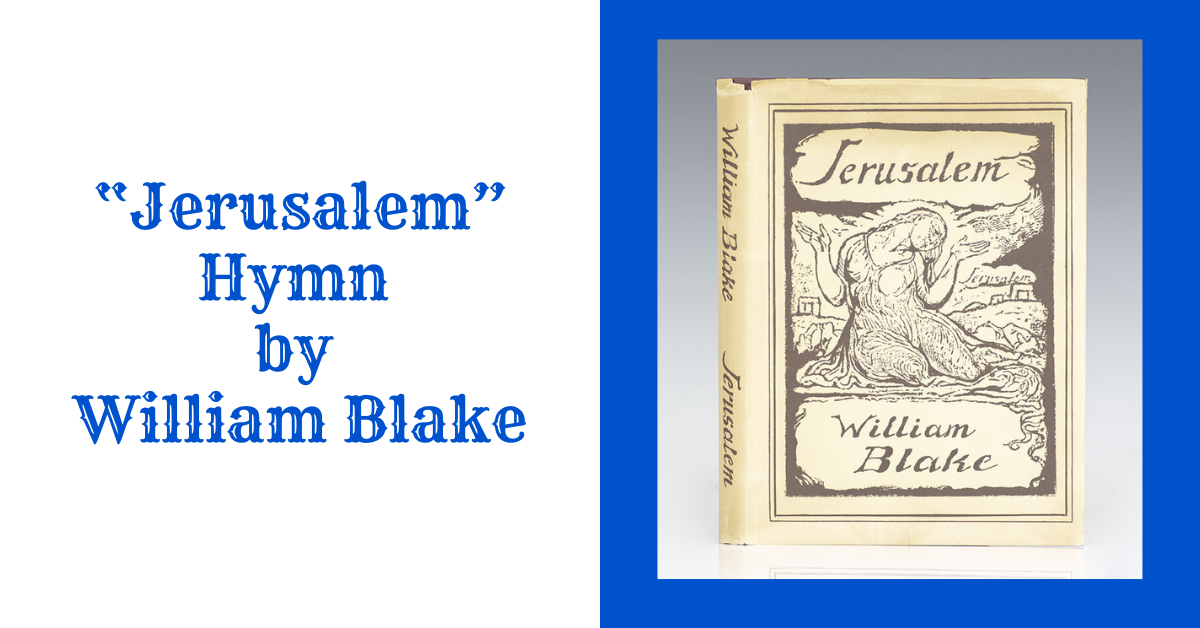Introduction of “Jerusalem”
“Jerusalem” by William Blake, one of the prestigious American writers and holy men is a contemplative literary work. First appearing in 1804, the poem presents a realistic picture of the industrial revolution. It also highlights how adaptable humans are, emphasizing significant shifts that have taken place on Earth since the time of Jesus’s birth. The poem became popular because it depicts a conflict between the writer and the outside world.
Analysis of “Jerusalem” Hymn by William Blake
The poem revolves around the idea of transition. The poem begins with an emotion of surprise when the speaker questions the holy birth of Jesus upon England’s green mountains among the satanic hills. Further, he states this is the same England that God might have walked in. First, he acknowledges the beauty of this place before becoming enraged upon seeing that the beauty has been replaced with enormous constructions. However, in the second stanza, the speaker asks questions, wondering if God accidentally touched down in his nation. Furthermore, he questions whether Jesus established New Jerusalem amidst his nation’s cruel hills. The speaker draws a comparison between the ideal heaven and what would exist in industrialized England now. Additionally, he connects biblical themes with Greek mythological terms. He ends this thought-provoking poem on a positive note of restoring God’s heaven.
Major Themes in “Jerusalem”
Major themes of the poem include transformation, spirituality, the industrial revolution, and natural beauty. In this poem, the speaker draws a sharp contrast between the old and the New England. In addition, he imagines a serene and fortunate England and wonders if God has ever visited the hills that are currently encircled by darkness. He draws attention to the negative repercussions of industrialization in this short poem. It severed man’s ties to the divine and gave rise to a host of social ills, including child labor, hazardous labor, and corruption. The speaker believes that the industrial revolution has replaced God’s light with darkness, which is why he calls it a demonic transformation. He laments this wicked change and holds out hope for the restoration of once-lost tranquillity and beauty.
To read the full poem, click here.
Analysis of Poetic Elements Used in “Jerusalem” Hymn by William Blake
Poetic elements are instruments that enable writers to more effectively communicate their ideas. The poem by William Blake employs a few literary elements, the analysis of which is provided below.
- Assonance: The repeating of vowel sounds in a line is known as assonance. Examples of this are the sounds /e/ in “Bring me my Spear: O clouds unfold” and /o/ in “Shine forth upon our clouded hills.”
- Anaphora: This is the term used to describe how certain verses repeat a word or phrase in the first section. Blake emphasized certain points in the opening part of the poem by using the phrase “bring me” twice.
- Consonance: Consonance is the repeating of consonant sounds in a line. Examples of consonant repetitions are the sounds /t/ in “Until We Have Built Jerusalem” and /n/ in “On England’s Pleasant Pastures Seen.”
- Diction: The poem uses powerful imagery, symbolism, and rhetorical tactics to create descriptive diction.
- End Rhyme: The stanza is made melodic by the employment of end rhyme. In this poem, William Blake employs end rhymes like “hills/mills,” “desire/fire,” and “hand/land.”
- Enjambment: Enjambment is a poetic device in which a notion flows from one line to the next without stopping or line break. William Blake has used this technique throughout the poem.
- Irony: Irony is a figure of speech where words are employed in a way that contrasts their intended meaning with their actual meaning. The poem illustrates the irony of how England has changed drastically over time.
- Imagery: Readers can see things through their five senses through the use of imagery. In this poem, William Blake makes use of imagery from lines like “I will not cease from Mental Fight,” “Shine forth upon our clouded hills,” and “Bring me my bow of burning gold.”
- Metaphor: This is a figure of speech in which two objects with differing natures are impliedly compared. The poem illustrates how man’s revolutionary thoughts have changed the planet by using revolution as an extended metaphor.
- Quatrain: A quatrain is an excerpt from Persian poetry that consists of four lined stanzas. Here, the first and second stanzas are quatrains, just as the others such as:
“And did those feet in ancient time
Walk upon Englands mountains green:
And was the holy Lamb of God,
On Englands pleasant pastures seen.”
- Rhetorical Question: A rhetorical question is one that is addressed just to clarify a point, without expecting a response. In the poem’s second stanza, William Blake uses rhetorical questions like “Shine forth upon our clouded hills?” and “Among these dark Satanic Mills?” to highlight his points.
- Symbolism: Symbolism refers to the application of symbols to represent concepts and attributes, endowing them with meanings that deviate from their literal interpretations. The poem uses symbols like change, grit, and grief as symbols.
Suggested Readings

